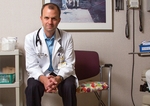AMA House of Delegates

Robert M. Wah, MD, will serve a year as president-elect before assuming the AMA presidency in June 2014. Photo by Peter Wynn Thompson / www.peterthompsonphoto.com
AMA meeting: Leaders speak to efforts on behalf of patients and physicians
■ The AMA president talks about critical issues facing doctors while the executive vice president gives a progress report on the strategic plan.
Chicago In her inaugural address, American Medical Association President Ardis Dee Hoven, MD, recalled how she was the only infectious diseases specialist in private practice in her community when AIDS was just appearing on the medical landscape.
Over time, treating people with AIDS in Lexington, Ky., made a lasting impression on her.
“My AIDS patients and their family members taught me about strength, about courage and about never, ever passing judgment about something you do not understand,” said Dr. Hoven, who also practices internal medicine.
In the June 18 speech, she urged physicians to work together on issues such as medical liability reform, innovations in medical education and health care technology improvements. Among her other goals as the AMA's 168th president: Eliminate the sustainable growth rate doctor payment formula in Medicare, and focus on the Association's strategic plan.
“By standing together, unified in vision and commitment, physicians can shape the health care system this country needs,” she said.
Also during the Annual Meeting, the House of Delegates elected Robert M. Wah, MD, president-elect over Joseph P. Annis, MD, also a member of the AMA Board of Trustees. Dr. Wah will serve in that position for one year and become AMA president in June 2014. Jeremy A. Lazarus, MD, a Denver psychiatrist, assumed the office of immediate past president.
Dr. Wah was chair of the AMA Board of Trustees from June 2011 to June 2012. He served in the house for 17 years and held several leadership positions.
“Working together, I know we can make significant strides in reducing chronic disease, educating future physicians and improving how care is provided to our patients,” said Dr. Wah, a reproductive endocrinologist and ob-gyn in McLean, Va.
Delegates re-elected Andrew W. Gurman, MD, an orthopedic surgeon from Hollidaysburg, Pa., as house speaker. Re-elected vice speaker was Susan R. Bailey, MD, an allergist, immunologist and pediatrician in Fort Worth, Texas. Named secretary was Carl A. Sirio, MD, an internist and critical care physician in Pittsburgh.
David O. Barbe, MD, MHA, a family physician from Mountain Grove, Mo., was elected to a second term on the board and is now board chair. Barbara L. McAneny, MD, a medical oncologist/hemotologist from Albuquerque, N.M., was chosen as chair-elect. Steven J. Stack, MD, an emergency physician from Lexington, Ky., assumed the office of immediate past chair.
Newly elected members of the board are: Maya A. Babu, MD, MBA, a resident in neurosurgery from Rochester, Minn.; Gerald E. Harmon, MD, a family physician from Pawleys Island, S.C.; and Ryan J. Ribeira, a medical student at the University of California, Davis School of Medicine in Sacramento.
Strategic plan's progress
At the meeting's opening session, AMA Executive Vice President and CEO James L. Madara, MD, gave delegates an update on the AMA's three-part strategic plan, which focuses on improving health outcomes, enhancing physician satisfaction and practice sustainability, and accelerating changes in medical education.
The AMA is working to identify and support models of care delivery and payment that promote doctor satisfaction and practice sustainability. The Association is teaming up with RAND Health to conduct research on 30 practices in six states, with the goal of creating resources and tools that doctors can use to improve satisfaction and sustainability, Dr. Madara said.
On June 14, the AMA unveiled the 11 medical schools that will receive funding over five years as part of the accelerating change in medical education initiative. The $11 million will go toward educational innovations such as increased use of health IT and models for competency-based student progression.
In April, the AMA announced that cardiovascular disease and type 2 diabetes would be the first two conditions targeted to improve health outcomes. At the opening session of the house, Dr. Madara described how the Association has partnered with the Johns Hopkins Armstrong Institute for Patient Safety and Quality for work relating to cardiovascular diseases and with the YMCA of the USA for work on type 2 diabetes. The effort with the YMCA includes increasing doctor referrals to the Y's diabetes prevention program.
“Our initial efforts to combat cardiovascular disease centers on patients with hypertension who have not been able to meet their blood pressure goals,” Dr. Madara told delegates. “Believe it or not, that's 30 million of our citizens.”












